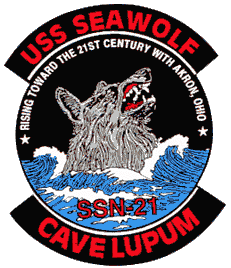 Seawolf-class
submarines were designed to operate autonomously against
the world's most capable submarine and surface threats.
The primary mission of the Seawolf was to destroy Soviet
ballistic missile submariness before they could attack
American targets. The Soviet submarines are one of the
most survivable elements of their intercontinental
ballistic missile arsenal. In addition to their
capabilities in countering enemy submarines and surface
shipping, Seawolf submarines are suited for battlespace-preparation
roles. Incorporation of sophisticated electronics
produces enhanced indications and warning, surveillance,
and communications capabilities. These platforms are
capable of integrating into a battle group's
infrastructure, or shifting rapidly into a land-battle
support role. Seawolf-class
submarines were designed to operate autonomously against
the world's most capable submarine and surface threats.
The primary mission of the Seawolf was to destroy Soviet
ballistic missile submariness before they could attack
American targets. The Soviet submarines are one of the
most survivable elements of their intercontinental
ballistic missile arsenal. In addition to their
capabilities in countering enemy submarines and surface
shipping, Seawolf submarines are suited for battlespace-preparation
roles. Incorporation of sophisticated electronics
produces enhanced indications and warning, surveillance,
and communications capabilities. These platforms are
capable of integrating into a battle group's
infrastructure, or shifting rapidly into a land-battle
support role.
The Seawolf features a strengthened
sail, designed to permit operations under the polar ice
cap for taking the fight to the Soviets in their own
front yard. It sports an eight-tube, double-deck torpedo
room to simultaneously engage multiple threats. It
incorporates the latest in quieting technology to keep
pace with the threat then posed by an aggressive Soviet
Union.
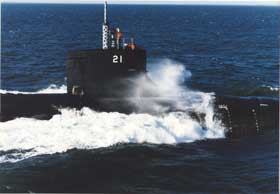 The
Seawolf has the highest tactical speed of any US
submarine. Much of the design effort was focused on
noise reduction, and it is expected that the fully
coated boat will restore the level of acoustic advantage
which the US Navy enjoyed for the last three decades.
The Seawolf's propulsion system makes it ten times more
quiet over its full range of operating speeds than the
Improved-688 class and 70 times more quiet than the
initial generation of Los Angeles 688-class submarines.
The Seawolf's quieter propulsion system will also enable
it to have twice the tactical speed as the I-688.
Tactical speed is the speed at which a submarine is
still quiet enough to remain undetected while tracking
enemy submarines effectively. Overall, the Seawolf's
propulsion system represents a 75-percent improvement
over the I-688's -- the Seawolf can operate 75 percent
faster before being detected. It is said that SEAWOLF is
quieter at its tactical speed of 25 knots than a LOS
ANGELES-class submarine at pierside. The
Seawolf has the highest tactical speed of any US
submarine. Much of the design effort was focused on
noise reduction, and it is expected that the fully
coated boat will restore the level of acoustic advantage
which the US Navy enjoyed for the last three decades.
The Seawolf's propulsion system makes it ten times more
quiet over its full range of operating speeds than the
Improved-688 class and 70 times more quiet than the
initial generation of Los Angeles 688-class submarines.
The Seawolf's quieter propulsion system will also enable
it to have twice the tactical speed as the I-688.
Tactical speed is the speed at which a submarine is
still quiet enough to remain undetected while tracking
enemy submarines effectively. Overall, the Seawolf's
propulsion system represents a 75-percent improvement
over the I-688's -- the Seawolf can operate 75 percent
faster before being detected. It is said that SEAWOLF is
quieter at its tactical speed of 25 knots than a LOS
ANGELES-class submarine at pierside.
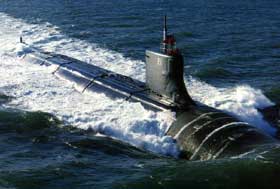 With
twice as many torpedo tubes and a 30% increase in
weapons magazine size over the Los Angeles (SSN
688)-class submarines, Seawolf is capable of
establishing and maintaining battlespace dominance.
Seawolf's inherent stealth enables surreptitious
insertion of combat swimmers into denied areas. SSN 23
will incorporate special-operations force capabilities,
including a dry deck shelter (DDS) and a new, specially
designed combat swimmer silo. The DDS is an
air-transportable device that piggy-backs on the
submarine and can be used to store and launch a swimmer
delivery vehicle and combat swimmers. The silo is an
internal lock-out chamber that will deploy up to eight
combat swimmers and their equipment at one time. With
twice as many torpedo tubes and a 30% increase in
weapons magazine size over the Los Angeles (SSN
688)-class submarines, Seawolf is capable of
establishing and maintaining battlespace dominance.
Seawolf's inherent stealth enables surreptitious
insertion of combat swimmers into denied areas. SSN 23
will incorporate special-operations force capabilities,
including a dry deck shelter (DDS) and a new, specially
designed combat swimmer silo. The DDS is an
air-transportable device that piggy-backs on the
submarine and can be used to store and launch a swimmer
delivery vehicle and combat swimmers. The silo is an
internal lock-out chamber that will deploy up to eight
combat swimmers and their equipment at one time.
Construction of the submarine has
relied on a new welding material to join the steel into
plates, hull subsections and large cylindrical sections.
The Seawolf is the first American attack submarine to
use a hull made entirely of high-pressure HY-100 steel
-- previous submarines used HY80 steel. HY-100 steel was
first used in submarines in the early 1960s in the
Navy's deep-diving SEA CLIFF and TURTLE,, which were
capable of reaching depths in excess of 10,000 feet.
More recently, the Moray, an advanced
conventional submarine designed by the Dutch shipyard
R.D.M. (Rotterdamsche Droogdok Maatschappij B.V),
incorporated HY-100 steel to achieve an operational
diving depth of 300 meters, and an incidental diving
depth of 360 meters.
The SEAWOLF program began in the
mid-1980s to ensure U.S. submarine superiority over
Soviet counterparts well into the next century. The
first U.S. attack submarine in decades designed from the
keel up to accommodate the latest weapons, sensors,
propulsion, and communication advancements, SEAWOLF
exceeded expectations during lead ship sea trials in the
summer of 1996. The test program included first
underwater submergence, acoustics trials, engineering
inspections and at-sea training for the crew. Seawolf (SSN
21) was commissioned on 19 July 1997 at Electric Boat
Shipyard.
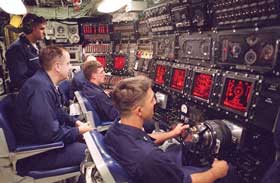 Seawolf
was projected to be the most expensive ever built, with
a total program cost for 12 submarines estimated in 1991
at $33.6 billion in current dollars. As many as 29
submarines were planned. The Navy's plans for Seawolf
would have resulted in spending 25 percent of the Navy's
shipbuilding budget on a ship that was designed for
threats that vanished with the end of the Cold War. In
the 1992 State of the Union address, President Bush [and
Defense Secretary Dick Cheney] proposed the rescission
of $2,765,900,000 previously appropriated for the
procurement of the second and third Seawolfs. Two
Seawolf Class submarines were authorized by Congress,
which in 1995 agreed to terminate the program at three
boats. President Clinton endorsed the construction of
SSN-23 as the most cost-effective method of retaining
the vitality of the submarine industrial base while
bridging the gap to the future New Attack Submarine. The
Fiscal Year 1998 $153.4 million budget request was the
final increment of funding required for the third
SEAWOLF to complete the program. The program continues
to be managed within the Congressionally mandated cost
cap. Seawolf
was projected to be the most expensive ever built, with
a total program cost for 12 submarines estimated in 1991
at $33.6 billion in current dollars. As many as 29
submarines were planned. The Navy's plans for Seawolf
would have resulted in spending 25 percent of the Navy's
shipbuilding budget on a ship that was designed for
threats that vanished with the end of the Cold War. In
the 1992 State of the Union address, President Bush [and
Defense Secretary Dick Cheney] proposed the rescission
of $2,765,900,000 previously appropriated for the
procurement of the second and third Seawolfs. Two
Seawolf Class submarines were authorized by Congress,
which in 1995 agreed to terminate the program at three
boats. President Clinton endorsed the construction of
SSN-23 as the most cost-effective method of retaining
the vitality of the submarine industrial base while
bridging the gap to the future New Attack Submarine. The
Fiscal Year 1998 $153.4 million budget request was the
final increment of funding required for the third
SEAWOLF to complete the program. The program continues
to be managed within the Congressionally mandated cost
cap.
On 10 December 1999 Electric Boat was
awarded an $887,113,628 modification to previously
awarded contract N00024-96-C-2108 for new efforts on USS
JIMMY CARTER (SSN 23) to accommodate advanced technology
for naval special warfare, tactical surveillance, and
mine warfare operations. Work will be performed in
Groton, Conn. (73%); Quonset Point, R.I.. (21%); and
Newport News, Va. (6%), and is expected to be completed
by June 2004.
Specifications |
| Builders |
General Dynamics Electric
Boat Division |
| Power
Plant |
One S6W
reactor
one shaft at with 52,000 shp with pumpjet
propulsor
Improved Performance Machinery Program Phase
II one secondary propulsion submerged motor |
| Length |
353 feet (107.6 meters) |
| Draft |
35 feet (10.67 meters) |
| Beam |
40 feet (12.2 meters) |
| Displacement |
7,460 ton surface
displacement
9,137 tons submerged displacement |
| Speed |
Official: 25+ knots (28+
miles per hour, 46.3+ kph)
Actual: 35 knots maximum submerged speed
Actual: 20 knots tactical ["silent"]
speed |
| Operating
Depth |
Official: "greater than
800 feet"
Actual: About 1600 feet
Jane's Fighting Ships: 2000 feet |
| Armament |
eight 660-mm torpedo tubes
50 Tomahawk
cruise missiles or
50 Harpoon
antiship missiles or
50 Mark
48 ADCAP torpedoes or
up to 100 mines |
| Crew |
12 Officers; 121 Enlisted |
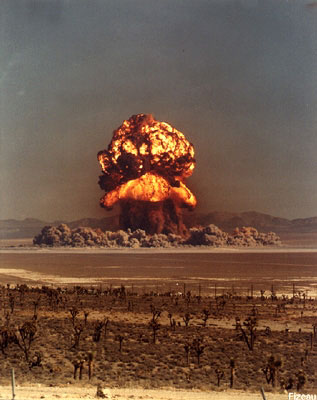 |
|
|